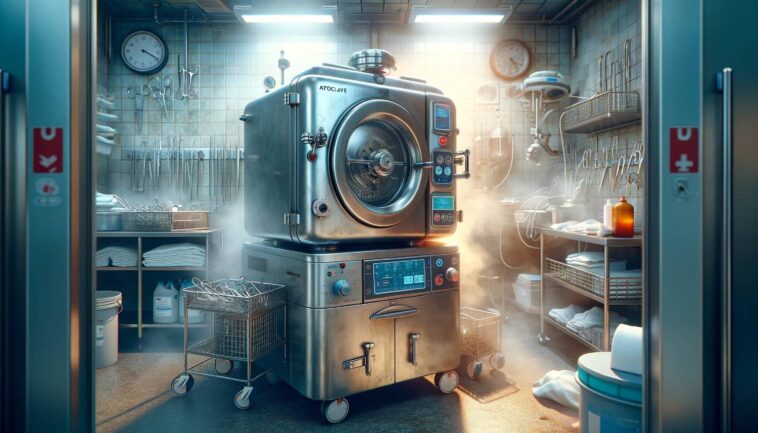In the healthcare domain, where patient safety and infection control are paramount, high-temperature steam devices play a pivotal role. These remarkable machines, often referred to as autoclaves, are indispensable tools in the battle against pathogens and the maintenance of stringent hygiene standards within healthcare facilities. This listicle delves into the profound significance of high-temperature steam devices like an autoclave for hospitals and explores how they contribute to ensuring the well-being of patients and healthcare providers.
Table of Contents
Sterilization: A Fundamental Imperative
Sterilization stands as one of the fundamental pillars of healthcare. Ensuring that medical instruments, surgical equipment, and other reusable items are free from harmful microorganisms is essential for preventing infections. High-temperature steam devices are meticulously designed to perform this critical task. By subjecting items to extreme heat and pressure, they eliminate a wide range of bacteria, viruses, and fungi, making them safe for use in medical procedures.
Moreover, their ability to eliminate these pathogens goes beyond safeguarding patient health; it also contributes to the overall efficiency of healthcare facilities. With sterile instruments readily available, medical professionals can focus on providing care without concerns about infection risks.
Autoclaves: The Guardians of Hygiene
Autoclaves, the most commonly used high-temperature steam devices in healthcare, are often the unsung heroes of hospital operations. These devices work silently and efficiently behind the scenes, sterilizing everything from surgical instruments to laboratory equipment. They are designed to withstand the rigors of continuous use, ensuring that every sterilization cycle produces reliable results.
Furthermore, their reliability and consistency are the cornerstones of efficient healthcare operations. Healthcare providers can depend on autoclaves to consistently deliver sterile items that adhere to the highest hygiene standards. This reliability translates into smoother patient care and fewer disruptions due to instrument availability concerns.
Precision and Reliability
One of their key advantages is their precision and reliability. They are engineered to maintain a consistent temperature and pressure throughout sterilization, leaving no room for errors. Healthcare professionals can rely on autoclaves to consistently deliver sterilized items that meet the highest hygiene standards. These devices enable researchers to work confidently, knowing their equipment and materials are contaminant-free.
Versatility in Application
High-temperature steam devices are not limited to just one type of equipment or material. Their versatility allows them to sterilize various items, from small surgical instruments to bulky laboratory glassware. This adaptability is crucial for healthcare facilities that deal daily with diverse equipment and materials. Healthcare facilities can streamline their sterilization processes, reducing complexity and ensuring the right sterilization method is available for different instruments and materials.
Time-Efficiency
In the fast-paced environment of healthcare, time is often of the essence. High-temperature steam devices excel in this regard. They offer rapid sterilization cycles, enabling healthcare providers to maintain a steady supply of sterile equipment and minimize disruptions in patient care. This efficiency is especially critical in emergencies and surgeries where every second counts. Quick access to sterile instruments means that medical procedures can commence promptly, reducing the risk of complications and ensuring patient safety.
Economical and Environmentally Friendly
High-temperature steam devices are not only effective but also cost-effective. Their ability to sterilize and reuse medical instruments reduces the need for constant replacements, ultimately saving healthcare facilities money. Additionally, the environmental impact is reduced as fewer disposable items end up in landfills. These steam devices contribute to a more environmentally responsible healthcare system by minimizing disposable items and reducing waste.
Ensuring Patient Safety
The primary goal of any healthcare facility is to provide safe and effective patient care. High-temperature steam devices play a pivotal role in achieving this goal by ensuring that every instrument and equipment used in patient care is sterile. This significantly reduces the risk of healthcare-associated infections, which can be life-threatening for vulnerable patients.
Protecting Healthcare Workers
Healthcare workers are on the front lines of patient care and are exposed to various pathogens daily. High-temperature steam devices also ensure their safety by providing sterile instruments and equipment. This reduces the risk of healthcare workers contracting infections from contaminated tools, safeguarding their health.
Conclusion
In the intricate tapestry of healthcare, high-temperature steam devices like an autoclave for hospitals play a crucial role in upholding hygiene and patient safety. Their precision, reliability, versatility, and efficiency make them indispensable tools for healthcare facilities worldwide. As the healthcare industry continues to evolve, the importance of these devices remains unwavering, and their role in protecting patients and healthcare workers cannot be overstated. These steam devices are the silent guardians that ensure the healthcare system functions smoothly, safely, and effectively, always putting patient well-being at the forefront.

